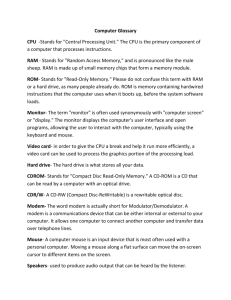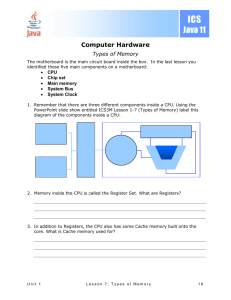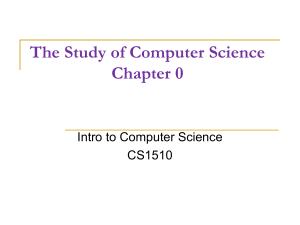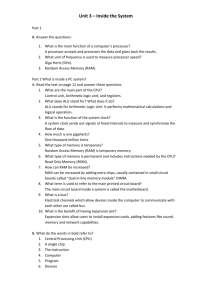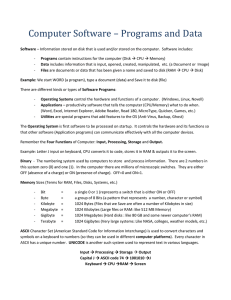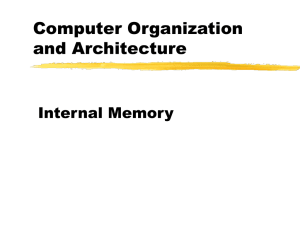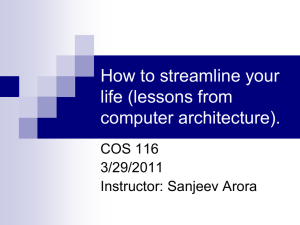How Memory Works
advertisement
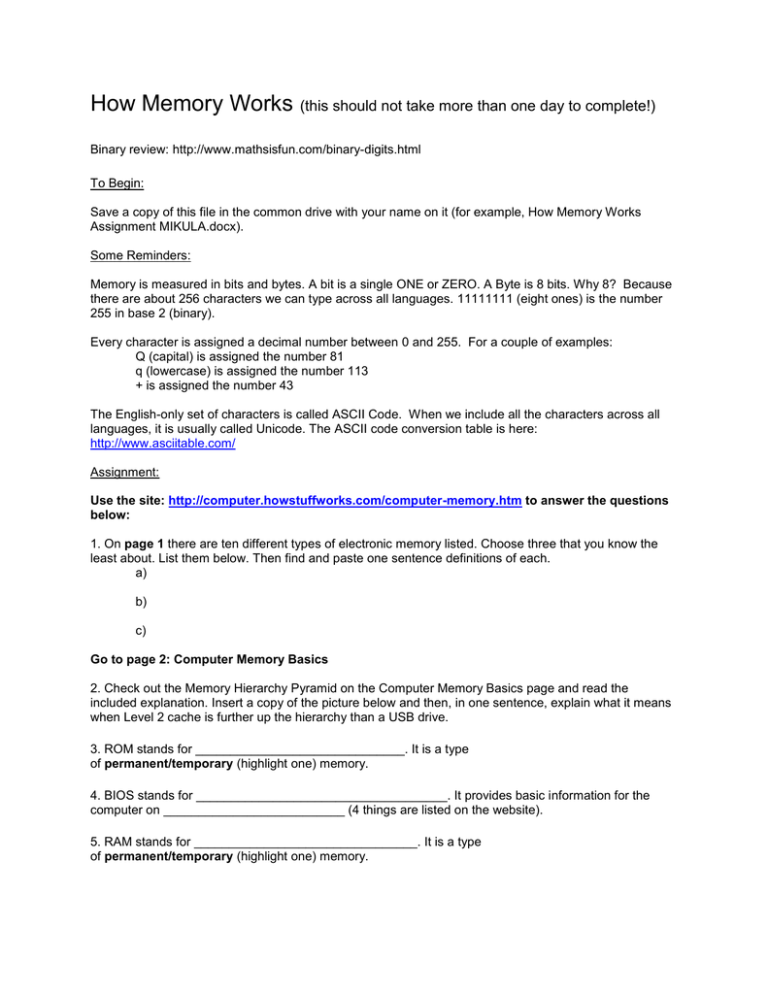
How Memory Works (this should not take more than one day to complete!) Binary review: http://www.mathsisfun.com/binary-digits.html To Begin: Save a copy of this file in the common drive with your name on it (for example, How Memory Works Assignment MIKULA.docx). Some Reminders: Memory is measured in bits and bytes. A bit is a single ONE or ZERO. A Byte is 8 bits. Why 8? Because there are about 256 characters we can type across all languages. 11111111 (eight ones) is the number 255 in base 2 (binary). Every character is assigned a decimal number between 0 and 255. For a couple of examples: Q (capital) is assigned the number 81 q (lowercase) is assigned the number 113 + is assigned the number 43 The English-only set of characters is called ASCII Code. When we include all the characters across all languages, it is usually called Unicode. The ASCII code conversion table is here: http://www.asciitable.com/ Assignment: Use the site: http://computer.howstuffworks.com/computer-memory.htm to answer the questions below: 1. On page 1 there are ten different types of electronic memory listed. Choose three that you know the least about. List them below. Then find and paste one sentence definitions of each. a) b) c) Go to page 2: Computer Memory Basics 2. Check out the Memory Hierarchy Pyramid on the Computer Memory Basics page and read the included explanation. Insert a copy of the picture below and then, in one sentence, explain what it means when Level 2 cache is further up the hierarchy than a USB drive. 3. ROM stands for ______________________________. It is a type of permanent/temporary (highlight one) memory. 4. BIOS stands for ____________________________________. It provides basic information for the computer on __________________________ (4 things are listed on the website). 5. RAM stands for ________________________________. It is a type of permanent/temporary (highlight one) memory. 6. Fill in the blanks from the following paragraph. In the list above, every time something is loaded or opened, it is placed into ___. This simply means that it has been put in the computer's temporary storage area so that the ___ can access that information more easily. The CPU requests the data it needs from RAM, processes it and writes new data back to RAM in a______ ______. In most computers, this shuffling of data between the CPU and RAM happens _______ of times every second. When an application is closed, it and any accompanying files are usually ______________ from RAM to make room for new data. If the changed files are not saved to a _____ _____ _____ before being purged, they are lost. Go to Page 3: Types of Memory Management 7. What is the cheapest form of read/write memory available today? 8. What does bit-size mean (as in 32-bit or 64-bit computer)? 9. The length of the clock cycle is used to determine a CPU’s processing speed. What unit of measurement is used? 10. RAM is not fast enough to keep up with the CPU. Therefore, some even higher speed memory is needed. What is this high speed memory called? Cool! Interested in more information? Check out page 4! Otherwise, go to page 5 11. Where are L1 and L2 cache physically located? L1 L2 12. What is a register? Where are registers physically located? Go to Future Shop, Best Buy, or Memory Express’s website (making sure you go to the CANADIAN site for the first two). Find a computer for not more than $1000 and answer the following questions about this computer. You may need to find the “Specifications” section to find the answer. 13. What is the speed of the CPU? _____________________GHz 14. Is there any information available about its cache size? If so, what is it? ______________________________________________________________ 15. What is the size of RAM? ________________________GB 16. What is the size of its hard drive? __________________GB You: ‘Hey, I want more than 90% on this assignment!’ Me: ‘Do these questions, then!’ Use whatever websites you wish to answer the following questions…BUT you must make an effort to explain what you learn in your own words. No copying and pasting. 17. What are the Memory Address Register and the Memory Data Register? What are they used for? 18. What is virtual memory? How does it relate to the hard drive?



